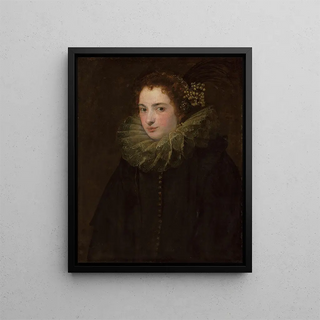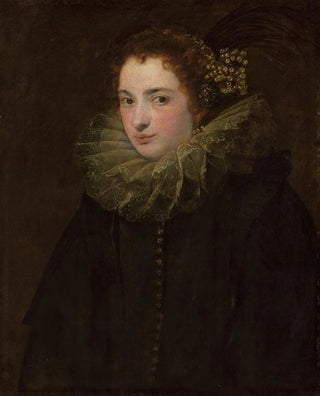Art print | Portrait of a noble woman - Antoine van Dyck


View from behind

Frame (optional)
Portrait of a Noble Lady - Antoine van Dyck – Captivating Introduction
The "Portrait of a Noble Lady" by Antoine van Dyck is an iconic artwork that embodies the elegance and sophistication of the 17th century. This painting, created by one of the greatest portraitists of his era, immerses us in a universe where beauty and social status blend harmoniously. Observing this piece, the viewer is immediately struck by the grace emanating from the subject, a noble lady whose gaze seems to capture the very essence of her aristocratic standing. Van Dyck, with his innate talent for depicting human figures, manages to transcend the simple portrait to offer a true ode to femininity and nobility.
Style and uniqueness of the artwork
Van Dyck's style is distinguished by his ability to combine realism and idealization. In this art print, the noble lady is depicted with remarkable finesse, every detail of her dress and accessories being carefully highlighted. The drapery, with its impressive fluidity, appears almost alive, while the colors chosen by the artist evoke an atmosphere of serenity and dignity. The light, in turn, plays a crucial role in the composition, illuminating the woman's face and creating a striking contrast with the background, which remains intentionally understated. This artistic choice allows the focus to be on the main subject, emphasizing her importance and charisma. Van Dyck succeeds in capturing not only the physical appearance of his model but also her character and aura, making this art print unforgettable.
The artist and his influence
Antoine van Dyck, born in 1599 in Antwerp, is one of the most influential artists of the Flemish Baroque. A pupil of Rubens, he quickly developed a style that is uniquely his own, characterized by a psychological approach to portraits. His mastery of color and light, combined with a keen sense of composition, enables him to create works that resonate with rare emotional depth. Van Dyck managed to charm European royal courts, becoming the official painter of Charles I of England, which attests to his prestigious status. His influence still endures today, inspiring many artists across the

Matte finish

View from behind

Frame (optional)
Portrait of a Noble Lady - Antoine van Dyck – Captivating Introduction
The "Portrait of a Noble Lady" by Antoine van Dyck is an iconic artwork that embodies the elegance and sophistication of the 17th century. This painting, created by one of the greatest portraitists of his era, immerses us in a universe where beauty and social status blend harmoniously. Observing this piece, the viewer is immediately struck by the grace emanating from the subject, a noble lady whose gaze seems to capture the very essence of her aristocratic standing. Van Dyck, with his innate talent for depicting human figures, manages to transcend the simple portrait to offer a true ode to femininity and nobility.
Style and uniqueness of the artwork
Van Dyck's style is distinguished by his ability to combine realism and idealization. In this art print, the noble lady is depicted with remarkable finesse, every detail of her dress and accessories being carefully highlighted. The drapery, with its impressive fluidity, appears almost alive, while the colors chosen by the artist evoke an atmosphere of serenity and dignity. The light, in turn, plays a crucial role in the composition, illuminating the woman's face and creating a striking contrast with the background, which remains intentionally understated. This artistic choice allows the focus to be on the main subject, emphasizing her importance and charisma. Van Dyck succeeds in capturing not only the physical appearance of his model but also her character and aura, making this art print unforgettable.
The artist and his influence
Antoine van Dyck, born in 1599 in Antwerp, is one of the most influential artists of the Flemish Baroque. A pupil of Rubens, he quickly developed a style that is uniquely his own, characterized by a psychological approach to portraits. His mastery of color and light, combined with a keen sense of composition, enables him to create works that resonate with rare emotional depth. Van Dyck managed to charm European royal courts, becoming the official painter of Charles I of England, which attests to his prestigious status. His influence still endures today, inspiring many artists across the






